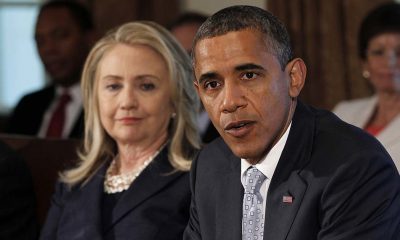World
Driverless cars good for our future: Study

New York: If driverless taxis roaming our cities become a reality, they would not only help cut our expenses but would also greatly reduce emissions of greenhouse gases, says researchers, including one of an Indian-origin.
The per-mile greenhouse gas emissions of an electric vehicle deployed as a self-driving, or autonomous, taxi in 2030 would be 63 to 82 percent lower than a projected 2030 hybrid vehicle driven as a privately owned car and 90 percent lower than a 2014 gasoline-powered private vehicle, the researchers calculated.
The study was co-authored by Jeffery Greenblatt and Samveg Saxena from from Lawrence Berkeley National Laboratory (Berkeley Lab), a US Department of Energy National Laboratory Managed by the University of California.
“When we first started looking at autonomous vehicles, we found that, of all the variables we could consider, the use of autonomous vehicles as part of a shared transit system seemed to be the biggest lever that pointed to lower energy use per mile,” said Greenblatt.
Almost half of the savings was attributable to “right-sizing,” where the size of the taxi deployed is tailored to each trip’s occupancy needs.
Many automakers and other companies are working on autonomous cars. Right-sizing is cost-effective for both the fleet owner and for passengers, and small one- and two-seat vehicles are being explored by researchers and companies.
To illustrate the concept, consider a single passenger with no luggage versus a party of four passengers with suitcases. The single passenger would require a much smaller taxi than the party of four, saving money for vehicle owners and passengers. Right-sizing, of course, assumes a fleet of taxis managed by a single entity.
“Most trips in the US are taken singly, meaning one- or two-seat cars would satisfy most trips,” Greenblatt said.
“That gives us a factor of two savings, since smaller vehicles means reduced energy use and greenhouse gas emissions,” Greenblatt added.
Another factor contributing to lower emissions for autonomous taxis is a cleaner electric grid. By 2030 power plants are expected to be using more renewable energy and emitting less pollution, meaning the greenhouse gas intensity of electricity would be lower.
The researchers also conducted an economic analysis to determine how cost-effective autonomous taxis would be. An autonomous taxi using today’s technology would be cheaper than an ordinary taxi not simply due to its greater energy efficiency, but also due to the fact that no operator would be required.
By 2030, autonomous taxis could be far cheaper than their driven counterparts, researcheres said.
The results were published online in the journal Nature Climate Change.
World
Lockdowns in China Force Urban Communities to Defy Censorship and Vent Frustration Online

Shanghai’s rich middle class is leading a wave of online dissent over the strict and prolonged lockdowns imposed in various parts of the country. Chinese internet censorship is struggling as patience is wearing thin in many urban centers, coming up with creative forms of online protests.
Social Media Posts Revealing Lockdown Tension in Shanghai
Drawn-out lockdowns are nothing new in China as authorities insist with the nation’s zero-Covid policy since the start of the pandemic. Currently over This time around, however, metropolitan areas like Shanghai are increasingly difficult to keep quiet, given that its more than 25 million residents have seen weeks of total isolation along with food shortages and many other service interruptions.
Dozens of towns and reportedly over 300 million Chinese citizens have been affected by lockdowns of different severity. As expected, urban netizens have been most outspoken over their difficulties by finding creative ways to get around state censorship and bans placed on topics, news comments and spontaneous campaigns.
Shanghai residents have been using mobile proxies and hijacking seemingly unrelated hashtags to talk about healthcare issues, delivery failures and the overall severity of their situation. The “positive energy” that the Chinese government wants to transmit during the recent prolonged series of lockdowns does not come naturally to those counting food supplies and online censors are working hard to filter words, trending topics and undesired social media sharing.
WeChat groups and message threads are under constant monitoring. Posts questioning the zero-Covid approach have been quickly deleted, including by leading Chinese health experts like Dr. Zhong Nanshan. Video footage is soon censored and protests and investigations are quickly made to disappear.
Where this has not worked, officials have exposed banners with warnings and outright threats like “watch your own mouth or face punishment”, while drones have been patrolling the city skies. Yet, if anything, this has led to further tensions and unspoken confrontation with Shanghai’s educated and affluent middle class.
Creative Online Solutions Harnessing Civic Energy
Announcements by Chinese social media that they would be publishing the IP addresses of users who “spread rumors” have not helped either. Tech industry research has shown that much of Asia’s tech-savvy population has a habit of using mobile proxies and other privacy tools, quickly finding workarounds to browse the internet freely and talk to the world about the hottest topics.
The sheer volume of forbidden posts is already a challenge for the very censorship system, experts explain. Unable to track all trending hashtags, state workers overlook topics that speak about the US, Ukraine or other popular news. Linking human rights elsewhere to their situation, Chinese online dissidents establish their informal channels and “hijack” the conversation to share personal or publicly relevant information about the Covid suppression in their town.
Sarcastic and satirical posts still dominate. Others hope to evade the censors by replacing words from famous poems or the national anthem. One thing is certain – social media, when harnessed with the right creativity, has proven its ability to mount pressure on the government in even some of the most strictly controlled tech environments like China.























